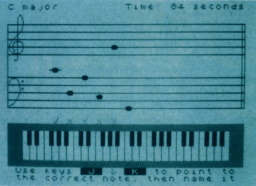


This month, Jon Bates takes a peek at a couple of music tutor programs from Childsplay and examines a combination Audio/Program cassette with hit tunes from the Commodore on one side and a database on the other. Next month he’ll probably be back making music with add-on hardware...

Note naming against a time limit in the key of C Major. It’s Cameron, photography person who’s making all the mistakes, not musical maestro Jon Bates!
In view of the wealth of music-making programs around, it’s probably not a bad idea to find out what those queer-looking blobs and sticks dancing along the lines in a music score actually mean if you want to get involved in tunesmithing with your Spectrum’s assistance. As most music software involves a piano-type keyboard, you’ll probably be lacking in the skills of note finding as well. So a program such as this could well be a bonus in actually getting you to understand what music scores are all about.
Parts One and Two concern themselves with the actual names of notes and their relative positions on the lines and spaces. On loading up, the menu offers you option of playing games, getting an introduction to the world of lines and spaces and a tour of the theory behind it all.
Diving straight into the games there are various levels of difficulty. Note names are displayed on screen to help you and notes can be entered either by keys 1 to 8 (which correspond to the notes A to G) or by moving a cursor over a keyboard on the screen. One thing that was quite useful, educationally, was the section where the player has to match up the pitch of a note that has to be found with the pitch that you think it is. The really keen could turn off the screen and play by ear!
Each game is timed and the resulting score shown at the end. If you get a decent enough score you are allowed into the composing section. Here you enter your own tune and have the dubious privilege of hearing it back — although with all the notes being the same length and played at a pretty pedestrian playback speed I found this a bit tiresome. Rests appeared here without any previous explanation. It would have been nice to have been able to access the composing section direct from the menu.
Part Two introduces sharps and flats and revises Part One, but doesn’t have a composing option. All of a horrible sudden there are piles of key signatures without any lead up other than in the on-screen theory pages. Generally the idea is good and is one that has been covered no better by similar programs. But I have a feeling that it tends to defeat itself by having a theory section which consists of pages of text and the theory side does not actually take an active part in the program. The games could be more imaginative and make more use of colour and graphics. Although interactive music learning is obviously the way forward, it won’t succeed if the program is little more than an electronic personification of a stuffy music teacher.
Producer: Mupados
Price: £4.99
Available only through WH Smiths
‘What’s this?’, I hear you scream. ‘CRASH doing reviews for ZZAP! products!?' Not quite. Let me explain. Datahits is a cassette containing computer-generated theme music from five best-selling Commodore games in audio form on one side: a sort of ‘Greatest Hits' compilation of computer game soundtracks. The other side has a database program which runs on the Spectrum. The database enables you to file your cassettes and stack the titles of the programs complete with the tape-counter number in the database. The filing system doesn’t have to be used for computer games — the database can be adapted for records and audio cassettes. The Softwhere system, although fairly simplistic is quite adequate if, like me, you can lose track of programs and music cassettes within minutes. (Don’t suppose it’d make any difference to Mr Liddon’s lifestyle — ED.) It has a fairly large capacity which, at full stretch, can contain over 20,000 titles! It’s just a shame the programmers didn’t include an option to print out the contents of the database — such a facility would have made the software much more useful.
The audio side features Commodore renditions of the music from Rambo, Neverending Story, Ghostbusters, Crazy Comets and Hypersports. The Commodore is aided by several chunks of hardware (samplers, drum machines and sequencers) and the result is not bad at all. The sound quality is very good (and so it should be for £4.99). If I was to be a bit critical I would say that some of the arrangements lack imagination and the resulting sounds can be a little wearing after a bit. I also failed to hear the ‘stereo dance-mix’ effect that the insert promised.
Definitely A for effort, though. What we now await is a Spectrum-generated cassette. If anyone out there has been busy cranking their 128’s and all other 48K music add-ons into musical life please, send me a copy — I’d be very interested to hear from Spectrum composers. (Usual address: Jon Bates, CRASH, LUDLOW.) This could open up a whole new ball-game in the record market. I wonder how long before we see music that originated as a game soundtrack reworked for the charts?